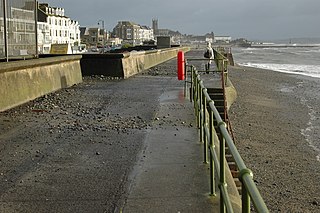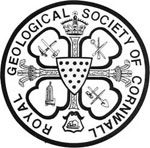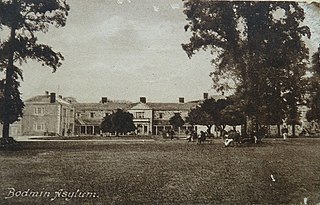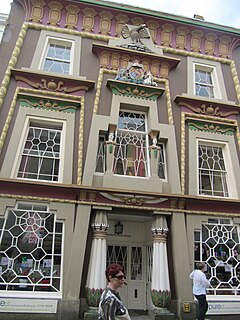
Marazion is a civil parish and town, on the shore of Mount's Bay in Cornwall, UK. It is 2 miles (3.2 km) east of Penzance and the tidal island of St Michael's Mount is half-a-mile offshore. At low water a causeway links it to the town and at high water passenger boats carry visitors between Marazion and St Michael's Mount. Marazion is a tourist resort with an active community of artists who produce and sell paintings and pottery in the town's art galleries.

Penzance is a town, civil parish and port in the Penwith district of Cornwall, United Kingdom. It is the most westerly major town in Cornwall and is about 64 miles (103 km) west-southwest of Plymouth and 255 miles (410 km) west-southwest of London. Situated in the shelter of Mount's Bay, the town faces south-east onto the English Channel, is bordered to the west by the fishing port of Newlyn, to the north by the civil parish of Madron and to the east by the civil parish of Ludgvan. The civil parish includes the town of Newlyn and the villages of Mousehole, Paul, Gulval, and Heamoor. Granted various royal charters from 1512 onwards and incorporated on 9 May 1614, it has a population of 21,200.
The year 1819 in architecture involved some significant architectural events and new buildings.

Morrab Gardens are a municipal garden covering 1.2 ha to the south of Penzance town centre, Cornwall. It is known for its Mediterranean and sub-tropical plants; and for housing the Morrab Library in the grounds.
Thomas Hardwick (1752–1829) was an English architect and a founding member of the Architects' Club in 1791.

James Piers St Aubyn, often referred to as J P St Aubyn, was an English architect of the Victorian era, known for his church architecture and confident restorations.

Penzance railway station serves the town of Penzance in west Cornwall, England. It is the terminus of the Cornish Main Line from Plymouth, 327 miles (526 km) from London Paddington via Bristol Temple Meads, and is the southernmost railway station in Great Britain. The first station opened in 1852 and through travel to and from London commenced from 1859 with the opening of the Royal Albert Bridge. The station was rebuilt by the Great Western Railway in 1876 and the current layout was the result of a further rebuilding in the 1930s. In 2020 the station is owned by Network Rail and managed by Great Western Railway who also operate the train services, together with CrossCountry.

Chyandour is a small settlement within the town of Penzance in west Cornwall, United Kingdom. It is on the north-east edge of the town straddling the A30 trunk road. The Chyandour Brook rises near Carfury and flows into Mount's Bay at Chyandour. Before 1934 Chyandour was in the parish of Madron and was the site of a large tin smelting works.

Wherrytown is a small settlement in west Cornwall, United Kingdom, on the east side of the Laregan River, between Newlyn and Penzance. It was formerly in the civil parish of Madron and was incorporated into the Borough of Penzance in 1934 when local government was reorganised.

The Morrab Library is an independent library based in Penzance, Cornwall in the UK.
Charles Campbell Ross was a British politician and banker based in Penzance, Cornwall. The grandson of the banker Joseph Carne through his eldest daughter Mary, he was educated at Brighton College, he was leading member of the Penzance Borough Council in the 1880s serving as mayor five times in 1877, 1878, 1879, 1881 and 1883. During this period he was also member of parliament for the St Ives constituency (1881–1885) as a member of the Conservative Party. The General Election of 1885 was "fiercely contested" and he was defeated by the Liberal candidate, Sir John St Aubyn.

The Royal Geological Society of Cornwall is a geological society based in Penzance, Cornwall in the United Kingdom. It was founded in 1814 to promote the study of the geology of Cornwall, and is the second oldest geological society in the world, after the Geological Society of London which was founded in 1807.

John Foulston was an English architect who was a pupil of Thomas Hardwick and set up a practice in London in 1796. In 1810 he won a competition to design the Royal Hotel and Theatre group of buildings in Plymouth, Devon, and after relocating he remained Plymouth's leading architect for twenty-five years.

Penlee House is a museum and art gallery located in the town of Penzance in Cornwall, and is home to a great many paintings by members of the Newlyn School, including many by Stanhope Forbes, Norman Garstin, Walter Langley and Lamorna Birch. Penlee House is currently operated by Penzance Town Council in association with Cornwall Council. Its most well-known painting is The Rain It Raineth Every Day by Norman Garstin who lived for many years in Wellington Terrace, on the edge of the park.

Poltesco is a hamlet and valley in the parish of Grade-Ruan, on the Lizard Peninsula, Cornwall, UK. The lower part of the valley is owned by the National Trust and was once the site of a stone industry that exported carved ornaments to the rest of Britain and Europe.

St Lawrence's Hospital was a mental hospital in Bodmin, Cornwall, England, UK. Part of the hospital has been converted to residential accommodation and the remainder has been demolished. It is a Grade II* listed building.

The Market Building in Penzance is a Grade I listed building situated at the top of Market Jew Street, Penzance.

St Mary's Church, Penzance is a Grade II* listed parish church in the Church of England in Penzance, Cornwall.

Egyptian Revival architecture in the British Isles is a survey of motifs derived from Ancient Egyptian sources occurring as an architectural style. Egyptian Revival architecture is comparatively rare in the British Isles. Obelisks start appearing in the 17th century, mainly as decorative features on buildings and by the 18th century they started to be used in some numbers as funerary or commemorative monuments. In the later 18th century, mausoleums started to be built based on pyramids, and sphinxes were used as decorative features associated with monuments or mounted on gate piers. The pylon, a doorway feature with spreading jambs which support a lintel, also started to be used and became popular with architects.

All Saints’ Church, Tuckingmill is a Grade II listed parish church in the Church of England in Pendarves Street, Tuckingmill, Camborne, Cornwall.



















